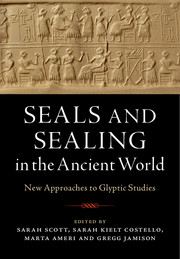 Seals and Sealing in the Ancient World
Seals and Sealing in the Ancient World Book contents
- Seals and Sealing in the Ancient World
- Seals and Sealing in the Ancient World
- Copyright page
- Contents
- Notes on Contributors
- Illustrations
- Plates
- Tables
- Acknowledgments
- Preface
- Abbreviations
- Chapter One Introduction: Small Windows, Wide Views
- Part I The Ancient Near East and Cyprus
- Part II South Asia and the Gulf Region
- Part III Egypt
- Part IV Aegean
- References
- Endnotes
- Index
Part I - The Ancient Near East and Cyprus
Published online by Cambridge University Press: 24 April 2018
- Seals and Sealing in the Ancient World
- Seals and Sealing in the Ancient World
- Copyright page
- Contents
- Notes on Contributors
- Illustrations
- Plates
- Tables
- Acknowledgments
- Preface
- Abbreviations
- Chapter One Introduction: Small Windows, Wide Views
- Part I The Ancient Near East and Cyprus
- Part II South Asia and the Gulf Region
- Part III Egypt
- Part IV Aegean
- References
- Endnotes
- Index
Summary
Seals as administrative tools have their origin in the sixth millennium BCE in the Syro-Mesopotamia heartland of the Tigris and Euphrates valley. Beginning as stamp seals, cylindrically shaped seals were invented at the same time as proto-cuneiform writing, in the middle of the fourth millennium BCE. While the site of their invention is still uncertain, the cylinder seal continued to be closely associated for the next 3,000 years with all of the cultures that adapted cuneiform to represent their spoken language. This introductory overview of seals and sealings in greater Mesopotamia will begin with a brief summary of the history of scholarship. It will present a summary of the iconographic, stylistic, and functional evolution of Mesopotamian glyptic through the middle of the second millennium BCE, placing emphasis on the changing roles of seals within the administrative system. It will end with several case studies of how seal iconography and style served as a medium through which long-distance cultural interaction was manifest across the larger ancient Near East extending from Egypt to the Indus and from the Persian Gulf to Central Asia. Hybrid styles and iconographies served to connect a vast and highly interconnected world, and they serve today to help us reconstruct that interaction.
- Type
- Chapter
- Information
- Seals and Sealing in the Ancient WorldCase Studies from the Near East, Egypt, the Aegean, and South Asia, pp. 11 - 124Publisher: Cambridge University PressPrint publication year: 2018
